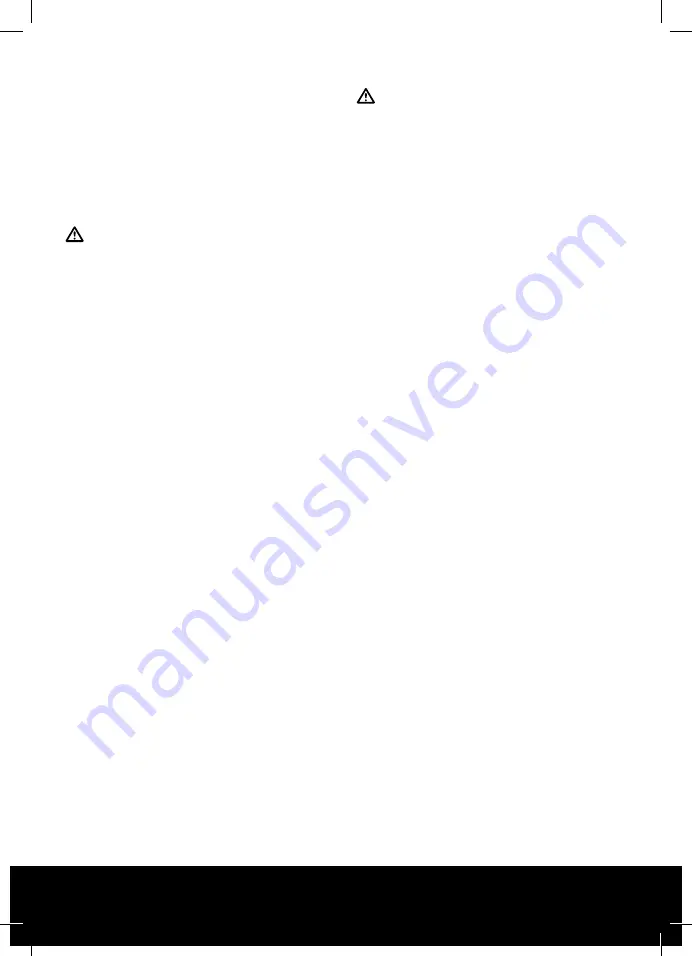
Wear ear-muffs.
The impact of noise can cause damage to hearing.
Total vibration values (vector sum of three
directions) determined in accordance with EN
60745.
Handle
Vibration emission value a
h
≤
2.5 m/s
2
K uncertainty = 1.5 m/s
2
Additional handle
Vibration emission value a
h
≤
2.5 m/s
2
K uncertainty = 1.5 m/s
2
IMPORTANT!
The vibration value changes according to the area
of application of the electric tool and may exceed
the specified value in exceptional circumstances.
Keep the noise emissions and vibrations
to a minimum.
• Only use appliances which are in perfect
working order.
• Service and clean the appliance regularly.
• Adapt your working style to suit the appliance.
• Do not overload the appliance.
• Have the appliance serviced whenever
necessary.
• Switch the appliance off when it is not in use.
• Wear protective gloves.
5. Before starting the equipment
Before you connect the equipment to the mains
supply make sure that the data on the rating plate
are identical to the mains data.
Always pull the power plug before making
adjustments to the equipment.
5.1 Dust extraction
5.1.1 Installing the dust extractor adapter
(Figure 3/Item 15) Slide the dust extractor adapter
(15) on to the connection for the dust extractor (6).
You can then connect a suitable dust extractor (a)
to the dust extractor adapter (15) (dust extractor
not supplied).
This will provide excellent dust extraction on the
workpiece. Check that all the parts are properly
connected.
Important!
The vacuum cleaner you use for the extraction
work must be suitable for the workpiece material.
5.1.2 Installing the dust collection box
(Figure 4/Item 14) Push the dust collection box (14)
to the dust extractor connection (6). Remove the
dust collection box in reverse order.
The dust is extracted directly via the sanding belt
into the dust container.
IMPORTANT!
For health safety reasons it is imperative that you
use a dust container or a dust extraction system via
the dust extraction adaptor!
5.2 Adjusting the additional handle
(Fig. 5/Item 2)
Slacken the screw (1) and move the additional
handle (2) to its optimal position. Lock the
additional handle (2) in place by tightening the
screw (1).
5.3 Changing the sanding belt
(Fig. 6-7/Item 13)
• Pull the clamping lever (12) to the outside to
relieve the tension in the sanding belt.
• Pull the used sanding/grinding belt off the drive
rollers.
• Slide the new sanding belt on to the drive rollers.
• Ensure that the direction of the sanding belt
(arrows on the inside of the sanding belt) is
identical to the direction of the belt sander
(arrow over the rear drive roller).
• Press the clamping lever (12) to the rear to
tension the sanding belt.
5.4 Adjusting the position of the belt
(Fig. 8/Item 8)
• Hold the belt sander with the sanding plate at the
top.
• Switch on the belt sander.
• By turning the setting screw (8) the belt position
should be set so that the sanding belt is at the
center of the two drive rollers.
5.5 Moving sanding belt cover
(Fig. 9 – 10/Item 9)
Important!
The moving sanding belt cover may only be swung
upwards if the pushbutton (7) has been pressed.
• Press the pushbutton (7) and at the same time
swing the cover (9) upwards.
• Release the pushbutton.
• The cover will lock in its end position.
• To swing the cover back down again, press
the push button (7) again. The cover can then
be swung downwards.
7
After Sales Support
EMAIL: service.australia@einhell.com
TEL: 1300 922 271
Summary of Contents for TITANIUM RT-BS 75
Page 3: ...2 After Sales Support EMAIL service australia einhell com TEL 1300 922 271 ...
Page 4: ...3 After Sales Support EMAIL service australia einhell com TEL 1300 922 271 ...
Page 5: ...4 After Sales Support EMAIL service australia einhell com TEL 1300 922 271 ...
Page 10: ...9 After Sales Support EMAIL service australia einhell com TEL 1300 922 271 ...
Page 11: ...10 After Sales Support EMAIL service australia einhell com TEL 1300 922 271 ...






























